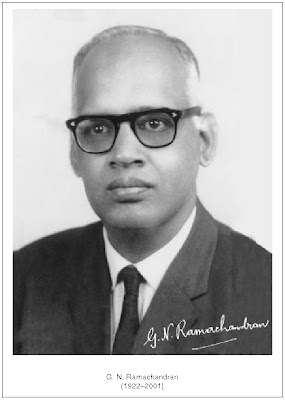G N Ramachandran
G. N. Ramachandran
G. N. Ramachandran was born on 8 October 1922 in Ernakulam, Kerala. His father G. Narayana Iyer was the principal of Maharaja’s college in Ernakulam. Ramachandran did his intermediate from Maharaja’s college and his B.Sc. (Hons) in Physics from St. Joseph’s College, Tiruchi. In 1942 he joined the Indian Institute of Science (IISc), Bangalore as a student in the Electrical Engineering department. However, under the influence of C.V. Raman, he shifted to Physics. He obtained his M.Sc. and then his Ph.D. in
1947, under Raman’s supervision. He then went to the Cavendish Laboratory, Cambridge and obtained his second Ph.D degree under Prof. Wooster.
He returned to India in 1949 and joined IISc as an Assistant Professor. In 1952, at the young age of 30, he moved to Madras as the Head of the Physics Department at the University of Madras. On the suggestion of J.D. Bernal, the crystallographer and chemist, who visited the University in 1952, he started work on determining the structure of the protein collagen, the fibrous protein found in skin, bone and tendon. Based on the limited data available at the time, in 1954, he proposed, along with Gopinath Kartha, the triple-helix structure for collagen, later revised in the light of new data to the coiled coil structure for biomolecules. This was a fundamental advance in the understanding of biomolecular structures. He and his colleagues C. Ramakrishnan and V. Sasisekharan went on to develop methods to examine and assess structures of biomolecules, in particular peptides. In 1963, this resulted in the famous Ramachandran map, which is an indispensable tool in the study of molecular structures today. His contributions in the field of X-ray crystallography such as anomalous dispersion, new kinds of Fourier syntheses, and X-ray intensity statistics are also extremely important. His 1971 paper with A.V. Lakshminarayanan on three-dimensional image reconstruction was to have important applications in Computer Assisted Tomography. (The 1979 Nobel Prize in Physiology or Medicine was awarded to A.M. Cormack and Sir G.N. Hounsfield for their work in CAT).
In 1971 Ramachandran returned to Bangalore to set up the Molecular Biophysics Unit at the IISc which is today a major research centre.
He was elected Fellow of the Royal Society in 1977 and was awarded the Shanti Swarup Bhatnagar award. In 1999, The International Union of Crystallography awarded him the prestigious Ewald Prize, which is given only once in three years. He was the editor of Current Science between 1950 and 1957.



Comments
Post a Comment